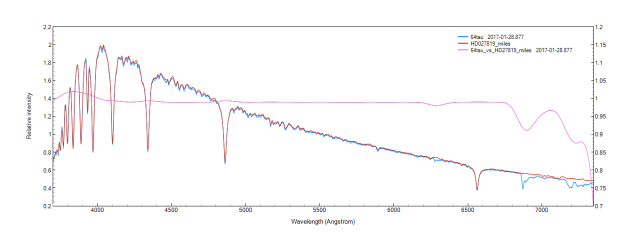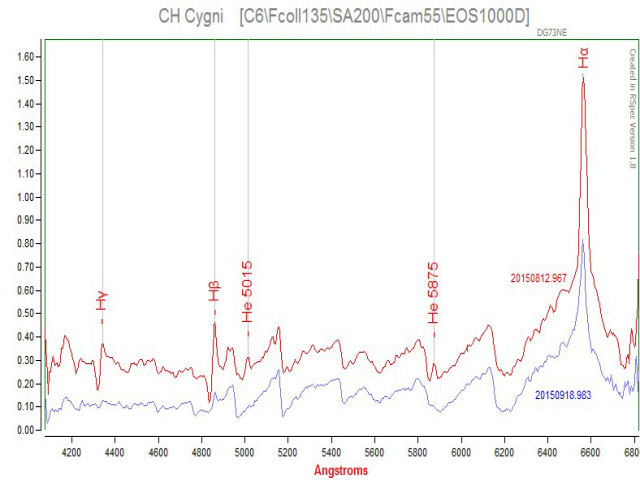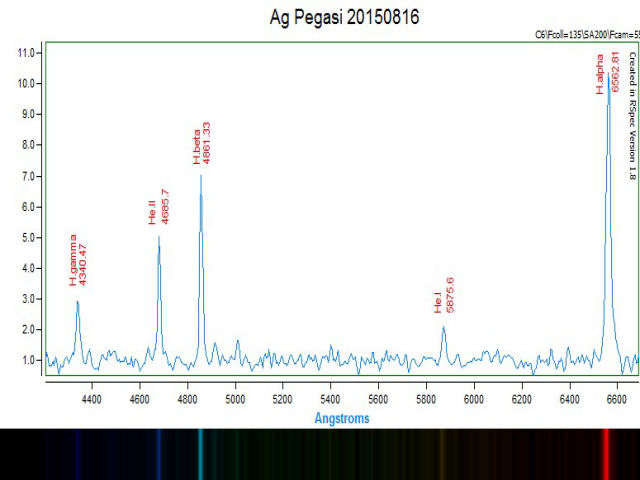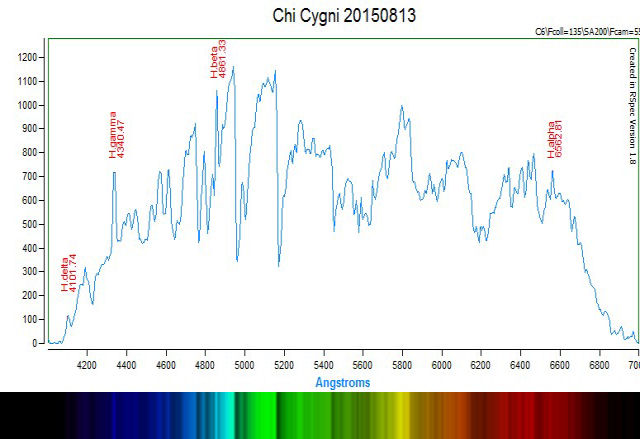Forum Replies Created
-
AuthorPosts
-
 john simpsonParticipant
john simpsonParticipantHi Robin,
Thanks for the suggestions & references. I’ve only been able to look at switching off optimised binning so far, but it makes no difference to the results. On the way I checked out switching everything out [no offset, dark or flat field correction, just raw images with no calibration]. I looked at the consistency in pixel location for several absorption lines across all the images and the standard deviations seem reasonable to me.
H.alpha=0.15px; H.beta=0.13px; H.gamma=0.11px; H.delta=0.16px; CaII=0.09px
I will look again at the data to see if the results show any obvious trends with time. However, more disturbing is that I have found what looks like a straylight problem with my set-up. If I turn up brightness & contrast to the maximum in the calculated image means, there is a streak of light running parallel to the spectrum [in all the images, to varying degrees]. It is approx 3% of the peak of the signal and about 50 pixels away. It wouldn’t have been summed in background removal, but not a good find. Am concentrating on this for the moment.
.png)
 john simpsonParticipant
john simpsonParticipantThanks for the quick response Andrew – yes, not the same, but similar air mass. The two in the graph are close together and image sequences were taken one after the other over 25mins or so. Altitude range 51-52 deg. I’m ALPY novice so I suspect something basically wrong about my set-up or what I’ve done to process, the errors seem to be too big compared to what’s been achieved by Robin. The annoying thing is that the corrected HD27819 seemed so close to its Miles library ref.
john s

 john simpsonParticipant
john simpsonParticipantHi David/Robin,
I am wondering if my interpretation of RMS performance index reported for dlambda is incorrect in this instance? It appears to be sqrt of sum of squares/3. [3 being order of polynomial -1].
john
 john simpsonParticipant
john simpsonParticipantRobin et al,
Thought I’d better make it clear that in my original post with the coefficients, I put in copy the lower set that is reported in the log file. . There is an upper set reported call the “primary dispersion” which I couldn’t relate to my pixel data, but guessed it was some master set in ISIS covering 11 different wavelengths, amended by my data in some way to allow setting of the research pixel windows of +/-7. I’m copying this set below anyway, just in case it’s relevant.
————————————————————————–
Primary dispersion :
Coefficient a4 : -2.657745E-13
Coefficient a3 : 7.117650E-09
Coefficient a2 : -6.547758E-05
Coefficient a1 : 0.53625
Coefficient a0 : -971.891
————————————————————————–
RMS : 0.125248 (en pixels)
————————————————————————–
Primary wavelength fit deviation
point #1 Lambda = 3770.630 px = 447.009 dx = -0.091
point #2 Lambda = 3797.300 px = 454.713 dx = 0.211
point #3 Lambda = 3835.390 px = 465.697 dx = -0.107
point #4 Lambda = 3889.050 px = 481.138 dx = -0.018
point #5 Lambda = 3970.080 px = 504.383 dx = 0.059
point #6 Lambda = 4101.750 px = 541.995 dx = -0.068
point #7 Lambda = 4340.480 px = 609.798 dx = -0.023
point #8 Lambda = 4861.340 px = 756.864 dx = 0.054
point #9 Lambda = 6562.850 px = 1246.125 dx = -0.096
point #10 Lambda = 6869.000 px = 1337.306 dx = 0.092
point #11 Lambda = 7605.000 px = 1560.933 dx = -0.012
————————————————————————–
BTW, if I calculate the RMS for the dx above I get 0.09241 and not 0.125248 [maybe it is weighted in some way not disclosed]. The same is true for the dlambda figures noted in my earlier post.
john
 john simpsonParticipant
john simpsonParticipantHi Robin, thanks for looking into this – I’ll do as you suggest and calibrate with Balmer line option for the time being.
john
 john simpsonParticipant
john simpsonParticipant Hi Andy, Thanks for your quick reply. Yes, hovering over spectrum plot in tab 5 seems OK – very noisy, 4 images done in hurry with poor guiding, but think OK. Too excited with ALPY. Will attach plot. Used HD27819 – Miles – A7v – had aimed to try to follow Robin’s earlier set that he posted, but ran out of weather. Used “Predefined Mode” ALPY 600 (Balmer Lines) in Spectral Box of General tab. This is what appears in log file.
Hi Andy, Thanks for your quick reply. Yes, hovering over spectrum plot in tab 5 seems OK – very noisy, 4 images done in hurry with poor guiding, but think OK. Too excited with ALPY. Will attach plot. Used HD27819 – Miles – A7v – had aimed to try to follow Robin’s earlier set that he posted, but ran out of weather. Used “Predefined Mode” ALPY 600 (Balmer Lines) in Spectral Box of General tab. This is what appears in log file.Wavelength fit deviation
point #1 x = 303.320 lambda = 3834.846 dlambda = 0.544
point #2 x = 318.889 lambda = 3889.410 dlambda = -0.360
point #3 x = 342.002 lambda = 3970.510 dlambda = -0.430
point #4 x = 379.334 lambda = 4101.764 dlambda = -0.014
point #5 x = 446.859 lambda = 4340.099 dlambda = 0.381
point #6 x = 593.448 lambda = 4861.471 dlambda = -0.131
point #7 x = 1081.158 lambda = 6562.787 dlambda = 0.023
point #8 x = 1179.852 lambda = 6872.013 dlambda = -0.013
————————————————————————–
Coefficient a4 : -4.314777E-10
Coefficient a3 : 7.466854E-07
Coefficient a2 : -3.481507E-04
Coefficient a1 : 3.55629
Coefficient a0 : 2767.495
————————————————————————–
RMS : 0.507955
————————————————————————–Don’t have ALPY Calibration Module – need coffers to refill for that. Have fashioned external fixed neon bulb in line with slit as per picture on Robin’s website, but didn’t use that – took some sky plus neon today though to play with later.
Am going to do it all over again next clear spell here, but will keep looking at it – still puzzled.
 john simpsonParticipant
john simpsonParticipantNick,
Think this is the problem I encountered [Santa forgot!]. You need this spacer from Shelyak [or elsewhere]
M42 (m) – C (f) spacer – BA0034.
Regards
 john simpsonParticipant
john simpsonParticipantNot sure if this helps or not, maybe just typo but your chart shows HD222368 [which is Miles listed in ISIS], but 132 Tau is HD 38751[also Miles listed] and quite some distance away?
Regards
john s
21 September 2015 at 9:21 pm in reply to: Wolf Rayets and Symbiotics spectra – a busy night! #577062 john simpsonParticipant
john simpsonParticipantHi Andy,
Yes – happy for you to use whatever you want. My reason for earlier question about normalisation of spectra was that I took sets of images in between the dates given in the figure. Haven’t processed all of them yet, but had it in mind to see if I could put some numbers to any changes by measuring equivalent widths if possible [Richard Walker document explains how to do this and Rspec has facility to do the measurements – not sure how accurate though – would be first try out of it].
Cheers
john s
21 September 2015 at 4:30 pm in reply to: Wolf Rayets and Symbiotics spectra – a busy night! #577057 john simpsonParticipant
john simpsonParticipantHi Steve, Andy,
Thought I’d add one more to your impressive collection – as well as AG Pegasi & Chi Cygni I chose to follow CH Cygni. Even at low resolution CH Cygni is a real gem for a beginner to follow and try to understand – changes in the spectrum abound – this plot shows changes to H and He lines in just a month [He disappear!]. I used iota CYG as reference. Wondered if you could give some tips on how to normalise in situations like this when continuum so broken up?
Cheers
john s

 john simpsonParticipant
john simpsonParticipant Hi Steve,
Hi Steve,Yes, think our posts did cross. I agree too with your logic, would be best if all observers could use same reference, whatever it was agreed to be. Since still experimenting have made note to do comparison based on several references at next available opportunity to see what differences accrue. My efforts for AG Pegasi on 16th Aug. attached. A lot of noise, but H alpha, beta, gamma clear – also some He I & II lines.
 john simpsonParticipant
john simpsonParticipantHello Andy, Steve,
Thanks to both of you for posting your spectra – they are impressive and in my case certainly of great help because I can compare with my own low resolution spectra using SA200 & DSLR. I have been following Chi Cygni & AG Pegasi [and also CH Cygni] since July/Aug, at low reolution and at other end of learning curve to you. I have used several different references to correct for for instrument and atmospheric extinction effects, but am wondering if I should be using some recognised standard stars that are in common use – depending on target RA/DECL? So far I’ve tried to find a nearby A class star of roughly the same magnitude to use, but is there somewhere a preferred/recommended list?
Best Wishes
john s
 john simpsonParticipant
john simpsonParticipantAndy,
Thanks for posting your spectral profile of Chi Cyg. RSpec and an SA200 recent purchases for me, still experimenting with set-up and working through the tutorials, but couldn’t resist having a look after Gary’s first post. Confidence booster to see similarities in the profiles even though mine just a single 20 sec. image with C6/collimator/SA200/DSLR wavelength calibrated only. Thanks.
john s

-
AuthorPosts
